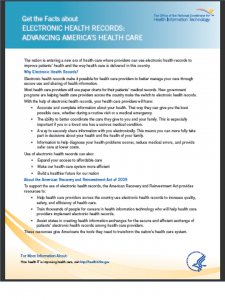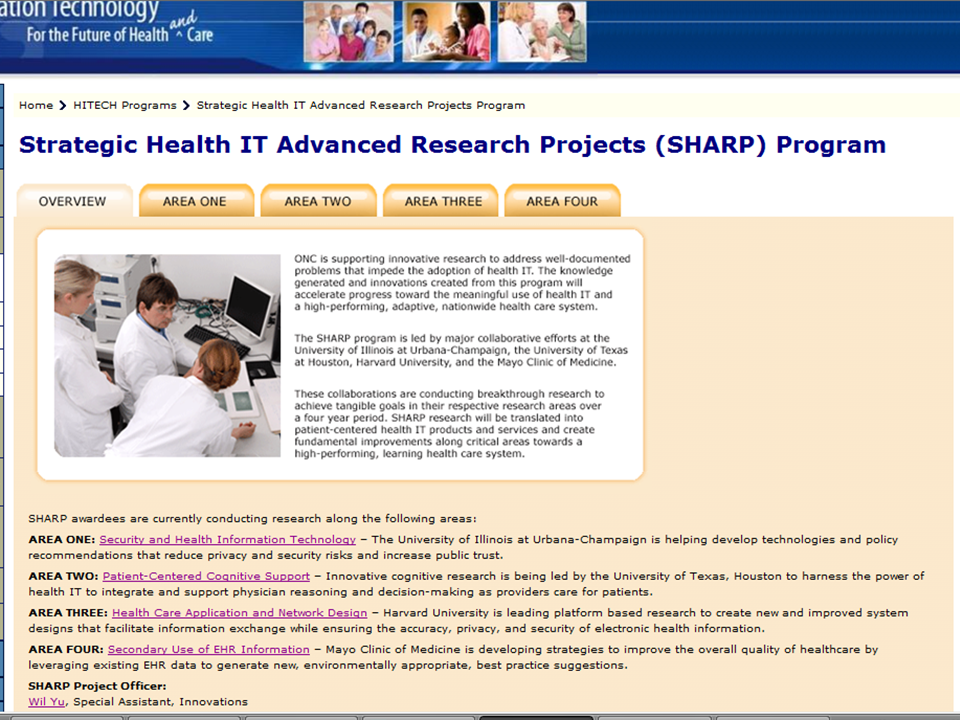National Health IT Week
September 10-14, 2012 Excerpted from http://www.healthit.gov/healthitweek/ on Sept 8, 2012
The Seventh Annual National Health IT Week  is being held September 10-14, 2012. Health IT Week brings together the entire health IT community under one umbrella to raise awareness about the power of health IT to improve the quality, safety, and cost effectiveness of health care.
is being held September 10-14, 2012. Health IT Week brings together the entire health IT community under one umbrella to raise awareness about the power of health IT to improve the quality, safety, and cost effectiveness of health care.
The events of the week provide a key opportunity for key stakeholders-vendors, provider organizations, payers, pharmaceutical/biotech companies, government agencies, industry and professional associations, research foundations, and consumer groups- to work together to highlight critical issues and advance a shared vision of improving the nation's health and health care through health IT. During Health IT Week, ONC has developed a specific theme upon which to build each day's events. We hope you are able to join us for as many as your schedule allows.
Health IT Events and Initiatives
-
Monday: Consumer eHealth/Blue Button
2012 Consumer Health IT Summit: Expanding Access to Health Information
Monday, September 10
10:00am – 1:00pm ET (NOTE: Breakout sessions will occur from 1:00 – 3:30PM for attendees who are participating in person)
Hubert H. Humphrey Building
200 Independence Avenue S.W.
Washington, D.C., 20201The 2012 Consumer Health IT Summit
 will bring together federal leaders including: Todd Park, U.S. Chief Technology Officer and Farzad Mostashari, National Coordinator, Office of the National Coordinator for Health Information Technology, and inspiring leaders from the private and non-profit sectors. ONC's Pledge Program has grown more than ten-fold since last year-the 2012 Consumer Health IT Summit is a chance to learn from and share your experiences with others who are leading the charge to empower consumers to be better partners in their health.
will bring together federal leaders including: Todd Park, U.S. Chief Technology Officer and Farzad Mostashari, National Coordinator, Office of the National Coordinator for Health Information Technology, and inspiring leaders from the private and non-profit sectors. ONC's Pledge Program has grown more than ten-fold since last year-the 2012 Consumer Health IT Summit is a chance to learn from and share your experiences with others who are leading the charge to empower consumers to be better partners in their health.View the latest agenda [PDF - 104 KB]

Event will be Webcast Live at www.hhs.gov/live.
-
Health IT Blog Carnival
The Health IT Blog Carnival
 is an open call for healthcare and IT industry bloggers who would like to comment on the impact health IT will have in 2013.
is an open call for healthcare and IT industry bloggers who would like to comment on the impact health IT will have in 2013. -
Tuesday: Improving Patient Care Through Meaningful Use
ONC – HRSA Webinar Demo of the New ONC Privacy and Security Training Game and Program Update for Safety Net Providers|
Tuesday, Septeber 11
10:00am – 11:00am ETThis webinar will feature a new training tool from the Office of National Coordinator for Health IT (ONC) Privacy and Security Group. ONC will demo an interactive training game for providers and staff on the "do's and don'ts" of privacy and security issues regarding health IT. This training tool can be used to help fulfill a safety net provider's HIPAA privacy training requirements. In addition, ONC will provide a privacy and security update on recent program changes and how they affect safety net providers.
Presenters:
- Laura Rosas, JD, MPH, Policy Analyst, ONC
- William Phelps Policy Analyst, ONC
-
PCPCC Advancing Primary Care through Health IT
Tuesday, September 11
2:00pm – 3:30pm ETThe Patient Centered Primary Care Collaborative (PCPCC) is holding a webinar featuring speakers from CMS, ONC, and NCQA to discuss various aspects of health information technology and the patient-centered medical home. Please join us for a free and informative webinar from 2:00-3:30pm ET on Tuesday, September 11, entitled "Advancing Primary Care through Health Information Technology".
Presenters:
- Richard Baron, MD, MACP, Group Director, Seamless Care Models, CMS Innovation Center
- Jacob Reider, MD, Acting Chief Medical Officer, ONC
- Mat Kendall, Director of Office Provider Adoption Support, ONC
- Johann Chanin, Director in Product Development, NCQA
-
Wednesday: Privacy and Security
NeHC Privacy and Security Programs|
Wednesday, September 12
11:00am – 12:00pm ETAs part of Health IT Week
 , National eHealth Collaborative
, National eHealth Collaborative  (NeHC) will offer a series of programs with the Office of the National Coordinator for Health IT (ONC) to highlight their various initiatives, including those related to privacy and security. Joy Pritts, Chief Privacy Officer at ONC will kick off the program and Laura Rosas, Privacy and Security Professional at ONC and Will Phelps, HIT Cyber Security Program Officer with HHS, will provide an interactive demonstration of Cybersecure: Your Medical Practice, a new avatar-based game meant to enhance organizations' understanding of privacy and security.
(NeHC) will offer a series of programs with the Office of the National Coordinator for Health IT (ONC) to highlight their various initiatives, including those related to privacy and security. Joy Pritts, Chief Privacy Officer at ONC will kick off the program and Laura Rosas, Privacy and Security Professional at ONC and Will Phelps, HIT Cyber Security Program Officer with HHS, will provide an interactive demonstration of Cybersecure: Your Medical Practice, a new avatar-based game meant to enhance organizations' understanding of privacy and security.Faculty:
- Joy Pritts, Chief Privacy Officer, ONC
- Laura E. Rosas, JD, MPH, Privacy and Security Professional, Office of the Chief Privacy Officer, ONC
- Will Phelps, HIT Cyber Security Program Officer, US Department of Health and Human Services
URL: http://www.nationalehealth.org/HITWeek-Security

Fee: No charge
-
Thursday: Standards, Interoperability, and Health Information Exchange
NeHC Standards & Interoperability Framework
Thursday, September 13
1:00p – 2:30pm ETContinuing with the HIT Week Program Series, National eHealth Collaborative
 (NeHC) will offer a program with Deputy National Coordinator David Muntz and Director of the Office of Science and Technology, Dr. Doug Fridsma to lead a discussion on the progress of the Standards and Interoperability Framework. Dr. Holly Miller from MedAllies, Inc. and David Tao from Siemens Healthcare will discuss the S&I Framework from the perspective of a provider and a vendor respectively.
(NeHC) will offer a program with Deputy National Coordinator David Muntz and Director of the Office of Science and Technology, Dr. Doug Fridsma to lead a discussion on the progress of the Standards and Interoperability Framework. Dr. Holly Miller from MedAllies, Inc. and David Tao from Siemens Healthcare will discuss the S&I Framework from the perspective of a provider and a vendor respectively.Faculty:
- David Muntz, Principal Deputy National Coordinator, ONC
- Dr. Doug Fridsma, Director, Office of Standards and Interoperability, ONC
- Dr. Holly Miller, Chief Medical Officer, MedAllies, Inc.
- David Tao, Senior Key Expert and Interoperability Champion, Siemens Healthcare
URL: http://www.nationalehealth.org/HITWeek-Standards

Fee: No charge
-
Friday: Quality and Health IT
eHC Quality in Health IT Webinar
Friday, September 14
11:00am – 12:00pm ETThe final webinar of the HIT Week Program Series
 , National eHealth Collaborative
, National eHealth Collaborative  (NeHC) will provide a program featuring Dr. Farzad Mostashari, Dr. Carolyn Clancy, and Dr. Patrick Conway to discuss how ONC, AHRQ, and CMS are collaborating to leverage health IT to improve healthcare quality. Speakers will provide a vision for the quality measurement enterprise of the future as well as the necessary steps to transition to health IT-enabled measurement, reporting and feedback that drives improvement in care and outcomes. They will also identify challenges moving forward in realizing this vision, including the need for continued public-private collaboration to continuously evolve and improve the enterprise.
(NeHC) will provide a program featuring Dr. Farzad Mostashari, Dr. Carolyn Clancy, and Dr. Patrick Conway to discuss how ONC, AHRQ, and CMS are collaborating to leverage health IT to improve healthcare quality. Speakers will provide a vision for the quality measurement enterprise of the future as well as the necessary steps to transition to health IT-enabled measurement, reporting and feedback that drives improvement in care and outcomes. They will also identify challenges moving forward in realizing this vision, including the need for continued public-private collaboration to continuously evolve and improve the enterprise.Faculty:
- Dr. Farzad Mostashari, National Coordinator for Health Information Technology, ONC
- Dr. Carolyn Clancy, Director, Agency for Healthcare Research and Quality (AHRQ)
- Dr. Patrick Conway, Chief Medical Officer, Director, Office of Clinical Quality Standards and Quality , Centers for Medicare and Medicaid Services (CMS)
URL: http://www.nationalehealth.org/HITWeek-Quality

Fee: No charge
-
HRSA Leadership Tips During a Health IT Implementation Webinar
Friday, September 14
2:00pm – 3:30pm ETThis webinar focuses on the importance of leadership in successfully steering an organization through a health IT implementation. It features established leaders who have conducted more than 70 health IT implementations in health centers, rural health clinics, and critical access hospitals. The presenters will also focus on how leadership is important in helping staff, clinicians, patients, a safety net providers' board, and partners adjust to and overcome the barriers that typically accompany a health IT implementation and impede success. Lastly, the presenters will provide leadership examples of unique health IT implementation situations such as meeting meaningful use objectives, changing vendors, and implementing health IT in multiple provider sites. Presenters include:
- Terry Hill, MPA, Executive Director and Joe Wivoda, Chief Information Officer
National Rural Health Resource Center - Greg Wolverton, Chief Information Officer
White River Rural Health Center, Arkansas - Doug Smith, Executive Director
Greene County Healthcare, North Carolina
- Terry Hill, MPA, Executive Director and Joe Wivoda, Chief Information Officer
-
HIMSS "Health IT is…" Twitter Chat
Friday, September 14
On Friday, September 14, @HIMSS
 and @HealthStandards
and @HealthStandards  are moderating at #HITsm Twitter chat on National Health IT Week at 12 noon ET. More details including chat questions will be shared on the HL7 Standards blog
are moderating at #HITsm Twitter chat on National Health IT Week at 12 noon ET. More details including chat questions will be shared on the HL7 Standards blog  closer to the day.
closer to the day. -
Celebrate in Your Hometown
Find out 10 ways to get involved
 , whether externally in your community and/or by communicating the value of health IT within your own organization.
, whether externally in your community and/or by communicating the value of health IT within your own organization.View a full list of National Health IT activities taking places across the U.S.
 , or to visit the National Health IT Week website
, or to visit the National Health IT Week website  to learn more.
to learn more.It's also easy for individuals and organizations across the country to participate. Potential partners – including corporate, non-profit and academic institutions – should visit the National Health IT Week website Partners page
 to learn more about generating awareness of health IT in their communities.
to learn more about generating awareness of health IT in their communities.





